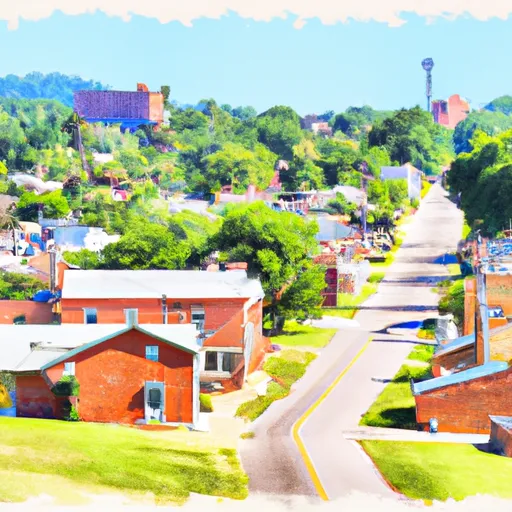-
 Snoflo Premium
Snoflo Premium
Get unlimited access to all our content
With no Ad interruptions! - Start Your Free Trial Login with existing account
Romance
Eden Index
Climate
7.9
•
Recreation
0.7
•
Community
•
Safeguard
3.4/10

Romance, Arkansas is a small town located in White County, nestled in the heart of the southern United States. The climate of Romance is characterized as humid subtropical, with hot and humid summers and mild winters. Average temperatures range from the high 80s°F (30°C) in summer to the low 40s°F (5°C) in winter. The region experiences moderate rainfall throughout the year, with the wettest months being during spring and early summer.
Hydrologically, Romance is blessed with several water bodies that provide opportunities for outdoor recreation. The Little Red River flows nearby, offering excellent fishing and boating activities. Anglers can enjoy catching trout, bass, and catfish in its waters. Additionally, Lake Barnett, located just a short distance from the town, provides opportunities for swimming, canoeing, and picnicking.
The town also boasts numerous outdoor recreation opportunities. The picturesque surroundings of Romance are ideal for hiking and camping enthusiasts. There are several nearby trails that wind through lush forests, offering breathtaking views and serene landscapes. The town also has several parks and recreational areas where residents and visitors can enjoy sports like basketball, baseball, and soccer.
In summary, Romance, Arkansas offers a typical humid subtropical climate with hot summers and mild winters. Its hydrology constituents include the Little Red River and Lake Barnett, providing ample opportunities for fishing, boating, and water activities. The town also offers various outdoor recreation opportunities, including hiking, camping, and sports in its parks and recreational areas.
What is the Eden Index?
The Snoflo Eden Index serves as a comprehensive rating system for regions, evaluating their desirability through a holistic assessment of climate health, outdoor recreation opportunities, and natural disaster risk, acknowledging the profound impact of these factors on livability and well-being.
Climate Health Indicator (CHI): 7.9
Romance receives approximately
1273mm of rain per year,
with humidity levels near 84%
and air temperatures averaging around
16°C.
Romance has a plant hardyness factor of
7, meaning
plants and agriculture in this region tend to thrive during the non-winter months.
By considering the ideal temperature range, reliable water supplies, clean air, and stable seasonal rain or snowpacks, the Climate Health Indicator (CHI) underscores the significance of a healthy climate as the foundation for quality living.
A healthy climate is paramount for ensuring a high quality of life and livability in a region, fostering both physical well-being and environmental harmony. This can be characterized by ideal temperatures, reliable access to water supplies, clean air, and consistent seasonal rain or snowpacks.
Weather Forecast
Streamflow Conditions
Lower White
Area Rivers
Lower White
Snowpack Depths
Lower White
Reservoir Storage Capacity
Lower White
Groundwater Levels
Recreational Opportunity Index (ROI): 0.7
The Recreational Opportunity Index (ROI) recognizes the value of outdoor recreational options, such as parks, hiking trails, camping sites, and fishing spots, while acknowledging that climate plays a pivotal role in ensuring the comfort and consistency of these experiences.
Access to outdoor recreational opportunities, encompassing activities such as parks, hiking, camping, and fishing, is crucial for overall well-being, and the climate plays a pivotal role in enabling and enhancing these experiences, ensuring that individuals can engage in nature-based activities comfortably and consistently.
Camping Areas
| Campground | Campsites | Reservations | Toilets | Showers | Elevation |
|---|---|---|---|---|---|
| Crossett RV Park | 119 | 68 ft | |||
| Trulock - Arkansas River | 15 | 195 ft | |||
| Cane Creek State park | None | 257 ft | |||
| Chemin - A - Haut State Park | None | 125 ft | |||
| Palmetto Island State Park | 96 | 5 ft | |||
| Acadiana Park | 75 | 42 ft | |||
| Abbeville RV Park | 55 | 10 ft | |||
| Opelousas City RV Park | 67 | 64 ft | |||
| Grand Marais County Park | None | 79 ft | |||
| Cypremort Point State Park | None | 3 ft |
Nearby Ski Areas
Catastrophe Safeguard Index (CSI):
The Catastrophe Safeguard Index (CSI) recognizes that natural disaster risk, encompassing floods, fires, hurricanes, and tornadoes, can drastically affect safety and the overall appeal of an area.
The level of natural disaster risk in a region significantly affects safety and the overall livability, with climate change amplifying these risks by potentially increasing the frequency and intensity of events like floods, fires, hurricanes, and tornadoes, thereby posing substantial challenges to community resilience and well-being.
Community Resilience Indicator (CRI):
The Community Resilience Indicator (CRI) recognizes that education, healthcare, and socioeconomics are crucial to the well-being of a region. The CRI acknowledges the profound impact of these elements on residents' overall quality of life. By evaluating educational resources, healthcare accessibility, and economic inclusivity, the index captures the essential aspects that contribute to a thriving community, fostering resident satisfaction, equity, and social cohesion.

